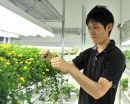(Press-News.org) JACKSONVILLE, Fla. — Researchers at Jacksonville's campus of Mayo Clinic have discovered a defect in a key cell-signaling pathway they say contributes to both overproduction of toxic protein in the brains of Alzheimer's disease patients as well as loss of communication between neurons — both significant contributors to this type of dementia.
Their study, in the online issue of Neuron, offers the potential that targeting this specific defect with drugs "may rejuvenate or rescue this pathway," says the study's lead investigator, Guojun Bu, Ph.D., a neuroscientist at Mayo Clinic, Jacksonville, Fla.
"This defect is likely not the sole contributor to development of Alzheimer's disease, but our findings suggest it is very important, and could be therapeutically targeted to possibly prevent Alzheimer's or treat early disease," he says.
The pathway, Wnt signaling, is known to play a critical role in cell survival, embryonic development and synaptic activity — the electrical and chemical signals necessary for learning and memory. Any imbalance in this pathway (too much or too little activity) leads to disease — the overgrowth of cells in cancer is one example of overactivation of this pathway.
While much research on Wnt has focused on diseases involved in overactive Wnt signaling, Dr. Bu's team is one of the first to demonstrate the link between suppressed Wnt signaling and Alzheimer's disease.
"Our finding makes sense, because researchers have long known that patients with cancer are at reduced risk of developing Alzheimer's disease, and vice versa," Dr. Bu says. "What wasn't known is that Wnt signaling was involved in that dichotomy."
Using a new mouse model, the investigators discovered the key defect that leads to suppressed Wnt signaling in Alzheimer's. They found that the low-density lipoprotein receptor-related protein 6 (LRP6) is deficient, and that LRP6 regulates both production of amyloid beta, the protein that builds up in the brains of AD patients, and communication between neurons. That means lower than normal levels of LRP6 leads to a toxic buildup of amyloid and impairs the ability of neurons to talk to each other.
Mice without LRP6 had impaired Wnt signaling, cognitive impairment, neuroinflammation and excess amyloid.
The researchers validated their findings by examining postmortem brain tissue from Alzheimer's patients — they found that LRP6 levels were deficient and Wnt signaling was severely compromised in the human brain they examined.
The good news is that specific inhibitors of this pathway are already being tested for cancer treatment. "Of course, we don't want to inhibit Wnt in people with Alzheimer's or at risk for the disease, but it may be possible to use the science invested in inhibiting Wnt to figure out how to boost activity in the pathway," Dr. Bu says.
"Identifying small molecule compounds to restore LRP6 and the Wnt pathway, without inducing side effects, may help prevent or treat Alzheimer's disease," he says. "This is a really exciting new strategy — a new and fresh approach."
INFORMATION:
Researchers from the University of Kentucky, Xiamen University in China, the University of Oklahoma and the Korea Brain Research Institute participated in the study.
This research was primarily supported by research grants from the National Institutes of Health (R01AG027924, R01AG035355, R01AG046205, P01AG030128 and P01NS074969), Alzheimer's Association and the Mayo Clinic Center for Regenerative Medicine Career Development Award.
About Mayo Clinic
Recognizing 150 years of serving humanity in 2014, Mayo Clinic is a nonprofit worldwide leader in medical care, research and education for people from all walks of life. For more information, visit 150years.mayoclinic.org, MayoClinic.org or newsnetwork.mayoclinic.org.
Mayo researchers reveal pathway that contributes to Alzheimer's disease
2014-09-19
ELSE PRESS RELEASES FROM THIS DATE:
A refined approach to proteins at low resolution
2014-09-19
Membrane proteins and large protein complexes are notoriously difficult to study with X-ray crystallography, not least because they are often very difficult, if not impossible, to crystallize, but also because their very nature means they are highly flexible. The result is that when a structure can be obtained it is often of low resolution, ambiguous and reveals a mosaic-like spread of protein domains that sometimes create more puzzles than they solve. [Schröder, Levitt & Brunger. (2014), Acta Cryst. D70, 2241-2255; doi: 10.1107/S1399004714016496 ]
Now, Gunnar Schröder ...
Reflected smartphone transmissions enable gesture control
2014-09-19
With almost all of the U.S. population armed with cellphones – and close to 80 percent carrying a smartphone – mobile phones have become second-nature for most people.
What's coming next, say University of Washington researchers, is the ability to interact with our devices not just with touchscreens, but through gestures in the space around the phone. Some smartphones are starting to incorporate 3-D gesture sensing based on cameras, for example, but cameras consume significant battery power and require a clear view of the user's hands.
UW engineers have developed a ...
Patients with advanced, incurable cancer denied palliative care
2014-09-19
Many patients with advanced, incurable cancer do not receive any palliative care, reveals new research to be presented later this month at the ESMO 2014 Congress in Madrid, Spain, 26-30 September. The findings are astonishing as they come at the same time as 15 new oncology centres in Europe, Canada, South America and Africa are being awarded the prestigious title of 'ESMO Designated Centre of Integrated Oncology and Palliative Care.'
SR I Dr Alexandru Grigorescu, medical oncology consultant at the Institute of Oncology Bucharest, Romania, member of the ESMO Palliative ...
Graphene sensor tracks down cancer biomarkers
2014-09-19
An ultrasensitive biosensor made from the wonder material graphene has been used to detect molecules that indicate an increased risk of developing cancer.
The biosensor has been shown to be more than five times more sensitive than bioassay tests currently in use, and was able to provide results in a matter of minutes, opening up the possibility of a rapid, point-of-care diagnostic tool for patients.
The biosensor has been presented today, 19 September, in IOP Publishing's journal 2D Materials.
To develop a viable bionsensor, the researchers, from the University of ...
Simple test can help detect Alzheimer's before dementia signs show: York U study
2014-09-19
TORONTO, Sept. 19, 2014 — York University researchers say a simple test that combines thinking and movement can help to detect heightened risk for developing Alzheimer's disease in a person, even before there are any telltale behavioural signs of dementia.
Faculty of Health Professor Lauren Sergio and PhD candidate Kara Hawkins who led the study asked the participants to complete four increasingly demanding visual-spatial and cognitive-motor tasks, on dual screen laptop computers. The test aimed at detecting the tendency for Alzheimer's in those who were having cognitive ...
Shrink-wrapping spacesuits
2014-09-19
For future astronauts, the process of suiting up may go something like this: Instead of climbing into a conventional, bulky, gas-pressurized suit, an astronaut may don a lightweight, stretchy garment, lined with tiny, musclelike coils. She would then plug in to a spacecraft's power supply, triggering the coils to contract and essentially shrink-wrap the garment around her body.
The skintight, pressurized suit would not only support the astronaut, but would give her much more freedom to move during planetary exploration. To take the suit off, she would only have to apply ...
New hadrosaur noses into spotlight
2014-09-19
Call it the Jimmy Durante of dinosaurs – a newly discovered hadrosaur with a truly distinctive nasal profile. The new dinosaur, named Rhinorex condrupus by paleontologists from North Carolina State University and Brigham Young University, lived in what is now Utah approximately 75 million years ago during the Late Cretaceous period.
Rhinorex, which translates roughly into "King Nose," was a plant-eater and a close relative of other Cretaceous hadrosaurs like Parasaurolophus and Edmontosaurus. Hadrosaurs are usually identified by bony crests that extended from the skull, ...
Researchers discover new gene responsible for traits involved in diabetes
2014-09-19
A collaborative research team led by Medical College of Wisconsin (MCW) scientists has identified a new gene associated with fasting glucose and insulin levels in rats, mice and in humans. The findings are published in the September issue of Genetics.
Leah Solberg Woods, Ph.D., associate professor of pediatrics at MCW and a researcher in the Children's Hospital of Wisconsin Research Institute, led the study and is the corresponding author of the paper.
The authors of the paper identified a gene called Tpcn2 in which a variant was associated with fasting glucose levels ...
Don't cry wolf: Drivers fed up with slowing down at inactive roadwork sites
2014-09-19
The results of the QUT Centre for Accident Research & Road Safety - Queensland (CARRS-Q) study have been presented at the Occupational Safety in Transport Conference (OSIT) which is being held on the Gold Coast and finishes today.
Dr Ross Blackman, a CARRS-Q road safety researcher, said speed limit credibility was being put at risk when reduced speed limits and related traffic controls remained in place at inactive roadwork sites.
"It's seen as crying wolf. If people are asked to slow down at roadwork sites but find there is no roadwork being undertaken they become ...
Long-distance communication from leaves to roots
2014-09-19
Leguminous plants are able to grow well in infertile land, and bear many beans that are important to humans. The reason for this is because most legumes have a symbiotic relationship with bacteria, called rhizobia, that can fix nitrogen in the air and then supply the host plant with ammonia as a nutrient.
The plants create symbiotic organs called nodules in their roots. However, if too many root nodules are made it will adversely affect the growth of the plants, because the energy cost of maintaining excessive nodules is too large. Therefore legumes must have a mechanism ...




